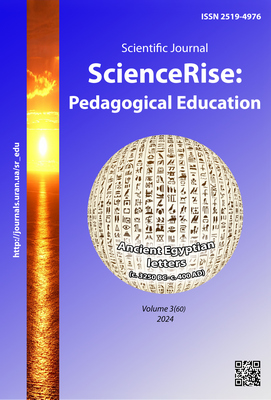Training of future ship engineers and electricians by means of competence, communicative and interdisciplinary approaches
DOI:
https://doi.org/10.15587/2519-4984.2024.305117Keywords:
interdisciplinary approach, communicative approach, competence approach, training cycle, maritime EnglishAbstract
The article examines the peculiarities of future ship engineers and electricians education by means of competence, communicative and interdisciplinary approaches;
emphasis is placed on the interdisciplinary connections of the disciplines of different cycles of training; it is underlined that the process of future seafarers education should be based on a competent, communicative and interdisciplinary approach, which will provide future specialists with efficiency in acquiring knowledge, skills and abilities.
The important competencies are defined in research by the educational goals of the competency-based approach that include knowledge and understanding (theoretical knowledge of an academic discipline, the ability to know and understand); knowledge of how to act (practical or operational application of knowledge in certain situations); knowledge of how to live (values as an integral element of perception and coexistence with others in a social context).
The interdisciplinary approach is an interdisciplinary movement of knowledge towards integrity, which involves a systematic study of the object and is a logical result of changes in each of the interacting knowledge systems, and is the source of the emergence of new trends towards their integration.
The study notes that the use of competency-based and interdisciplinary approaches contributes to the effective planning of professional training of a specialist; the analysis of the situation with the influence of interdisciplinary and competence approaches on the sequence of presentation of educational material when studying the disciplines of different training cycles allows to say that the use of these approaches contributes both to the in-depth assimilation of knowledge and skills by cadets and enriches their horizons allowing to establish relationships and interdependencies in the process of their education.
Attention is drawn to the fact that the communicative approach in studying the disciplines of the cycle of humanitarian and socio-economic education will contribute not only to communicative knowledge and skills (frequency, accuracy in formulating statements, the correct use of existing samples and the construction of one's own), but will also produce such universal skills as teamwork, creativity, flexibility, etc.
It has been proven that there is a need to apply the principles of interdisciplinary and competency-based approaches in educational and professional programs, training programs, curricula for more effective mastery of the future profession by ship engineers and electricians
References
- Trotsko, H. V. (1995). Profesiino-pedahohichna pidhotovka studentiv do vykhovnoi roboty v shkoli. Kharkiv: OVS, 241.
- Soroka, O. V. (2001). Pidhotovka maibutnoho vchytelia do intehratyvnoho vykorystannia obrazotvorchoho mystetstva v pochatkovii shkoli. [Extended abstract of PhD thesis; Pivdennoukrainskyi natsionalnyi pedahohichnyi universytet imeni K. D. Ushynskoho].
- Sushchenko, L. P. (2003). Teoretyko-metodolohichni zasady profesiinoi pidhotovky maibutnikh fakhivtsiv fizychnoho vykhovannia ta sportu u vyshchykh navchalnykh zakladakh. [Extended abstract of Doctoral thesis; Instytut pedahohiky i psykholohii profesiinoi osvity APN Ukrainy].
- Lytvyn, A. V. (2001). Vidbir i konstruiuvannia zmistu spetsialnykh dystsyplin u profesiino-tekhnichnykh navchalnykh zakladakh. Pedahohika i psykholohiia profesiinoi osvity, 3, 88–99.
- Voloshynov, S. A. (2012). Alhorytmichna pidhotovka maibutnikh sudnovodiiv z systemoiu vizualnoi pidtrymky v umovakh informatsiino-komunikatsiinoho pedahohichnoho seredovyshcha. [PhD dissertation; Khersonskyi derzhavnyi universytet].
- Sokol, I. V. (2011). Formuvannia profesiinoi kompetentnosti maibutnikh sudnovodiiv u protsesi vyvchennia fakhovykh dystsyplin. [PhD dissertation; Xersonska derzhavna morska akademiia MON Ukrainy].
- Kremen, V. H. (Ed.) (2004). Vyshcha osvita v Ukraini i Bolonskyi protses. Kyiv: Osvita, 384.
- Tuning Project (2006). Universytet Deusto (Ispaniia), universytet Hroninhena (Niderlandy). Education & culture. Socrates-Tempus, 101.
- Sova, M. O. (2005). Intehratsiia khudozhno-kulturolohichnykh znan u systemi profesiinoi pidhotovky vchytelia humanitarnykh dystsyplin. [Extended abstract of Doctoral thesis; Ukrainskyi derzhavnyi universytet imeni Mykhaila Drahomanova].
- Wang, B., Li, P. (2021). Interdisciplinary approaches to arts education: Exploring the link between creative thinking and mastering exact sciences. Thinking Skills and Creativity, 42, 100968. https://doi.org/10.1016/j.tsc.2021.100968
- Augsburg, T. (2014). Becoming Transdisciplinary: The Emergence of the Transdisciplinary Individual. World Futures, 70 (3-4), 233–247. https://doi.org/10.1080/02604027.2014.934639
- Bruce, A., Lyall, C., Tait, J., Williams, R. (2004). Interdisciplinary integration in Europe: the case of the Fifth Framework programme. Futures, 36 (4), 457–470. https://doi.org/10.1016/j.futures.2003.10.003
- Liashenko, U. I. (2016). Pedahohichni umovy pidhotovky maibutnikh sudnovykh mekhanikiv u protsesi vyvchennia profesiino-oriientovanykh dystsyplin. [PhD dissertation].
Downloads
Published
How to Cite
Issue
Section
License
Copyright (c) 2024 Uliana Liashenko

This work is licensed under a Creative Commons Attribution 4.0 International License.
Our journal abides by the Creative Commons CC BY copyright rights and permissions for open access journals.
Authors, who are published in this journal, agree to the following conditions:
1. The authors reserve the right to authorship of the work and pass the first publication right of this work to the journal under the terms of a Creative Commons CC BY, which allows others to freely distribute the published research with the obligatory reference to the authors of the original work and the first publication of the work in this journal.
2. The authors have the right to conclude separate supplement agreements that relate to non-exclusive work distribution in the form in which it has been published by the journal (for example, to upload the work to the online storage of the journal or publish it as part of a monograph), provided that the reference to the first publication of the work in this journal is included.








